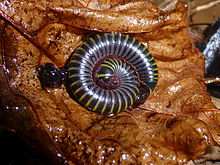Anadenobolus monilicornis, known as the yellow-banded millipede or bumble bee millipede, is a species of millipede in the family Rhinocricidae. It is native to the Caribbean and has also been introduced to the southeastern United States.[2]
| Anadenobolus monilicornis | |
|---|---|

| |
A. monilicornis in defensive position
 | |
| Scientific classification | |
| Domain: | Eukaryota |
| Kingdom: | Animalia |
| Phylum: | Arthropoda |
| Subphylum: | Myriapoda |
| Class: | Diplopoda |
| Order: | Spirobolida |
| Family: | Rhinocricidae |
| Genus: | Anadenobolus |
| Species: | A. monilicornis
|
| Binomial name | |
| Anadenobolus monilicornis | |
Description
editIndividuals are dark brown with distinctive yellow bands, and measure 2.5–3 centimetres (1.0–1.2 in) long. The legs and antennae are red.[3]
Ecology and behaviour
editThis species inhabits leaf litter. Birds and captive monkeys have been observed crushing these millipedes and rubbing their secretions on their wings or fur, potentially to repel insects. The secretions of millipedes may have some properties that repel insects.[3]
Distribution
editThis species is native to the Caribbean: it is found in Brazil, Venezuela, Suriname, Guyana, and on Barbados, Trinidad and Tobago, St. Maarten, Martinique, Dominica, Guadeloupe, Jamaica, Puerto Rico and Haiti.[4][5]
This species has been introduced to southern Florida, where it can occur in large numbers but is not considered a pest.[3]
References
edit- ^ "Anadenobolus monilicornis (von Porat, 1876)". Integrated Taxonomic Information System. Retrieved October 16, 2013.
- ^ Anadenobolus monilicornis
- ^ a b c "Yellow-banded millipede (Anadenobolus monilicornis)" (PDF). Institute of Food and Agricultural Sciences, University of Florida. August 2006.
- ^ {{cite and [Nagpur Maharashtra India] [ seminari hil balodyan] journal|last=Pérez-Asso|first=A. R.|author2=D. E. Pérez-Gelabert|title=Checklist of the millipeds (Diplopoda) of Hispaniola|journal=Boletín de la S.E.A.|year=2001|volume=28|pages=67–80|url=http://www.sea-entomologia.org/PDF/BOLETIN_28/B28-009-067.pdf}}
- ^ Chamberlin, Ralph V. (1918). "The Chilopoda and Diplopoda of West Indies". Bulletin of the Museum of Comparative Zoology: 151–262. Retrieved 15 October 2013.